Many years ago, perusing a guide to the Agia Irini gorge and surrounding area, a paragraph jumped off the page in front of me :
” …. below the road is Kato Prines village, full of trees and running water. Right here the gorge of Prines begins, which leads to the gorge of Agia Irini, which may be reached after one hour of hiking. At the end, and in order to reach the exit of the gorge, a rope may be necessary as this is a difficult passage. “
Lynne and I explored the upper reaches of the gorge, and later I completed the full descent first with Julie, the ‘Simply Crete’ rep here, then with Denis, a regular visitor from Holland. And the guide’s description was accurate – a rope was indeed necessary – except that the “one hour of hiking” took us four times as long.
In mid June, before the excessive summer heat made long walks impracticable, Phil, Laura and I drove 30 km from Paleochora, through Rodovani and Kambanos to Prines, to attempt to descend the gorge. Parking on the road, we set off and had walked maybe just 30m before a voice called to us (in Greek), “Are you looking for Agia Irini?” ” No,” I replied, “the Prines gorge”. “That is very difficult, a long way, and no path,” he cautioned. “Sounds just great,” enthused Laura, a young, athletic Rumanian, whilst Phil, a Welshman of, well …. more mature years, had to be dissuaded from returning to the car. “I know all that, and I’ve been before,” I persevered. Changing to English, our adviser shouted “Goodbye! “, and waved to us with an air of finality which didn’t bode well.
Undeterred, we left the main road and walked down through Kato Prines, passing two churches and the village cafenion. A third, smaller church is reached by turning right through a ‘gate’ (two wooden pallets) and along a narrow concrete path. And beyond that is the gorge, wide at this point. For a kilometre or so we followed a rough track, first on the right, then left of the dry riverbed. Several wire ‘gates’ through stock-control fencing were either open or easily unfastened. When the track ended, we followed the water course direct, leaving it occasionally to avoid large boulders, or to by-pass clusters of colourful oleander bushes which had benefitted from the heavy winter rains and grown tall.
Then, after a pleasant couple more km, the valley – almost imperceptibly – became narrower, steeper … and more serious. We used the rope to drop down a smooth wall of maybe two metres, and again on a less vertical, but longer fall. Then we reached the first “impasse”, a steep crack, overhanging at the top, of around 6m. First Laura, then Phil safely negotiated their way down, protected by the rope from above, and I joined them for lunch in the shade.
Time and memory play tricks, and I thought no great difficulties lay ahead. Then we reached a ledge formidably situated “on the edge of all things.” The valley floor was maybe ten metres below us, but looked far more, and the distance between us very intimidating. Trust is important (and essential!) here, and my two ‘explorers’ confidentally trusted me to safeguard them over the edge and lower them, hanging free on the rope, to the ground. I abseiled down to join them, and pulled in the double rope (leaving a tape & karabiner, if you find them!) Phil asked me how we could return up the gorge, if necessary, and probably already knew the answer … “we can’t!”
An enormous boulder blocking the gorge was passed underneath, carefully putting it back in position afterwards. We used the rope just once again, on a smooth slab more awkward than difficult, and then reached the point where, reads the guidebook : ” The horrifying crevinces (sic) of the gorge of Prines which joins the gorge of Agia Irini in an imposing embrace.”
From leaving the road at Prines, maybe a distance of 7 km, we had taken nearly four and a half hours. Laura was for turning north up Agia Irini and then back to the car, but age and wisdom prevailed over youth and beauty, and we went south, down the final kilometre of Agia Irini gorge to the Oasis taverna, and rehydrated with water, lemonade & orange, and more water.
Various ways of returning to Prines were discussed : walking or hitching into Sougia, and taking the Chania bus which meets the ‘Samaria’ ferry (often delayed). Or walking up to Moni and hoping for a lift via Rodovani. In the end, I’m rather ashamed to say, we rang for a taxi from Sougia and were there 40 minutes later.
Other than ourselves, and those mentioned above, I know of no-one who has traversed the Prines gorge. If you do it, please let me know – and if you find my sunglasses during the descent (Chinese ‘Rayban’, €5) they’re yours as a reward for the achievement.

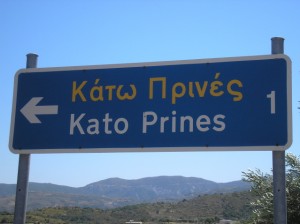
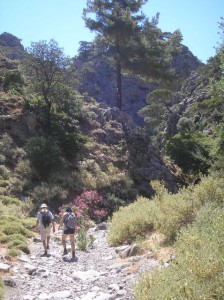
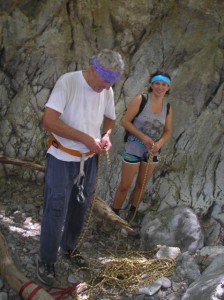
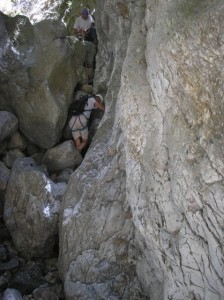
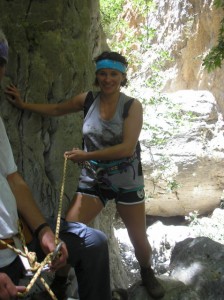
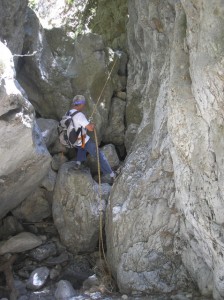
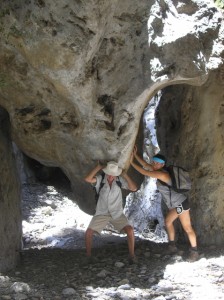

Recent Comments